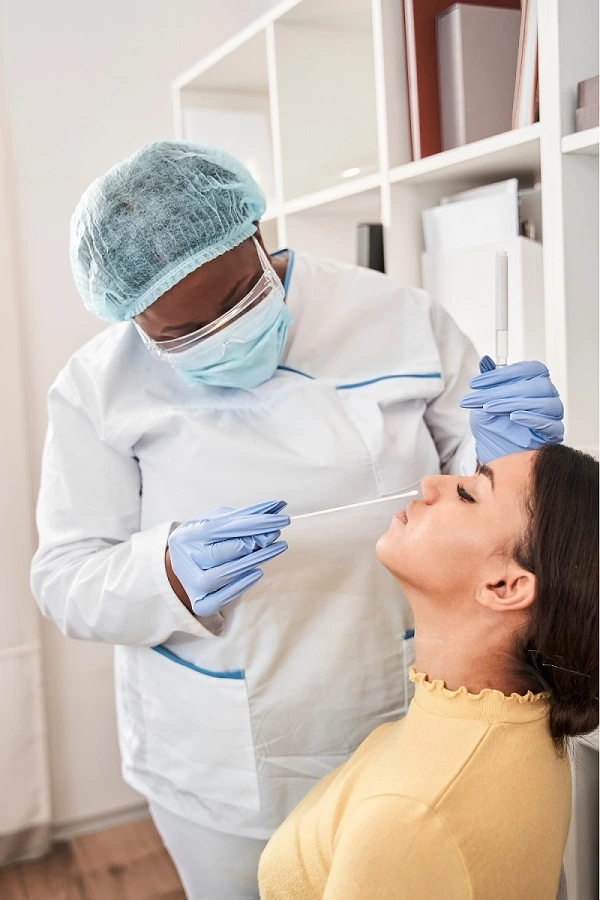The COVID-19 pandemic has brought about significant challenges, including the emergence of different forms of the virus known as variants. These variants, like the COVID-19 Variant BA 2.86, have sparked concern due to their potential impact on the spread and severity of the disease. By learning COVID Variants BA 2.86 symptoms, you can make informed decisions about your health and the safety of those around you.
It’s essential to grasp the symptoms associated with these variants to swiftly identify and respond to infections. In this article, we’ll explore these symptoms in easy terms, helping you understand the signs to look out for and the actions to take in the face of this evolving health challenge.
The Spread and Impact of Variant BA 2.86
The COVID-19 Variant BA 2.86, a notable mutation of the virus, has raised concerns due to its potential to spread and impact individuals differently than the original virus.
Global Distribution
Variant BA 2.86 has been identified in various regions worldwide, showing its ability to cross geographical boundaries swiftly.
This variant’s presence underscores the need for continued vigilance and adherence to preventive measures.
Increased Transmissibility
Research indicates that Variant BA 2.86 possesses a higher transmissibility rate compared to the original virus.

This means it can spread more easily from person to person, potentially leading to more cases in a shorter time.
Read Also: How to Sanitize Pillows After Covid?
Potential Severity
While research is ongoing, there are indications that Variant BA 2.86 might lead to varying degrees of illness severity.
Some cases could be milder, while others might still result in severe illness. Monitoring symptoms and seeking medical attention when necessary remains vital.
Covid Variants BA 2.86 Symptoms
COVID-19 Variant BA 2.86 introduces a range of symptoms that vary from the original virus. Recognizing these symptoms is essential for early detection and appropriate action.
As we face the emergence of the BA.2.86 variant of COVID-19, it’s crucial to understand its potential symptoms.
While it’s still early to pinpoint specific characteristics unique to this variant, it’s believed to share some similarities with other Omicron descendants.
Here’s a detailed look at the symptoms associated with BA.2.86:
Runny Nose and Sneezing
One of the key features of BA.2.86 is its potential to cause symptoms reminiscent of a common cold. These may include a runny or stuffy nose and frequent sneezing.
It’s important to note that these symptoms are milder than those seen in earlier strains of COVID-19.
Headache
Individuals infected with BA.2.86 might experience headaches. This symptom, along with nausea or vomiting, could be more common with this variant than others.
Interestingly, the loss of taste or smell, often seen with earlier variants, appears to be less prevalent in BA.2.86 cases.
Fatigue
Unusual tiredness or fatigue is another symptom that has been associated with BA.2.86. This might result from the variant’s unique characteristics, affecting how the body responds to the virus.
Sore Throat
A sore throat is one of the symptoms linked to BA.2.86. This suggests that the variant could have a greater impact on the upper airways compared to previous strains. Some experts have noted an increase in pharyngitis, which is inflammation in the throat, among BA.2.86 patients.
Fever
Fever is a common symptom reported by individuals infected with BA.2.86. In fact, research indicates that more than half of those with this variant experience elevated body temperatures. This fever is often considered one of the hallmark signs of COVID-19.
Uncommon or Atypical Symptoms
- Gastrointestinal Symptoms: Nausea, vomiting, and diarrhea, which may not always be present.
- Skin Changes: Rash or changes in skin color, occasionally observed.
- Eye Irritation: Redness, itching, or irritation of the eyes.
- Neurological Symptoms: Headaches, confusion, or dizziness in some cases.
- Cardiovascular Symptoms: Chest pain or palpitations, though rare.
Differentiation from Original COVID-19
COVID-19 Variant BA 2.86 shares common symptoms with the original virus, but individuals infected with this variant might experience some symptoms that differ.
It’s crucial to be aware of these distinctions to promptly identify potential infections.
As the medical community gathers more information, the spectrum of symptoms might evolve. Some individuals could also remain asymptomatic.
Staying informed about these potential variations assists in recognizing infections early.
Read Also: Ear and Jaw Pain on One Side Due to Covid
Seeking Medical Attention
If you experience symptoms resembling those associated with COVID-19 Variant BA 2.86, especially if they worsen or persist, consider seeking medical advice.
Timely testing and proper medical care can aid in managing symptoms and preventing further transmission.

Recognizing and Responding to Symptoms
When it comes to COVID-19 Variant BA 2.86, recognizing the symptoms promptly and responding effectively is crucial for your health and the well-being of those around you.
Monitoring for Symptoms
Stay attentive to your body’s signals, especially if you’ve been exposed to someone with Variant BA 2.86 or in an area with reported cases.
When to Consider Testing
If you experience any symptoms associated with Variant BA 2.86, such as fever, cough, shortness of breath, or loss of taste or smell, consider getting tested for the variant. Testing helps confirm your condition and prevents further spread.
Seeking Medical Care
Mild Symptoms: If your symptoms are mild, you can often manage them at home. Rest, stay hydrated, and isolate yourself from others to prevent transmission.
Severe Symptoms: If symptoms worsen, such as difficulty breathing, persistent chest pain, confusion, or bluish lips or face, seek medical attention promptly. Call your healthcare provider or emergency services.
Preventive Measures
While waiting for test results or if you suspect exposure, take preventive actions:
- Isolation: Stay home and avoid contact with others to prevent potential transmission.
- Hygiene: Practice good hand hygiene by washing your hands frequently with soap and water for at least 20 seconds.
- Masking: Wear a mask, especially if you need to be around others, to reduce the risk of spreading the virus.
- Inform Contacts: If you test positive for Variant BA 2.86, inform people you’ve been in close contact with so they can take appropriate precautions.
Following Official Guidelines
Adhere to the guidelines provided by local health authorities and public health agencies. They provide essential information on testing, isolation, and quarantine to curb the spread of the variant.
Read Also: What Does Covid Fatigue Feel Like?
Current Treatments and Vaccination
Understanding the available treatments and the importance of vaccination in the context of COVID-19 Variant BA 2.86 is essential for managing the variant’s impact on health.
Effectiveness of Vaccines
COVID-19 vaccines have shown effectiveness in reducing the severity of illness caused by Variant BA 2.86. Vaccinated individuals are less likely to experience severe symptoms or require hospitalization.
Types of Vaccines
Several types of vaccines, including mRNA vaccines and viral vector vaccines, have been developed to combat COVID-19.
These vaccines stimulate the immune system to create a defense against the virus, including its variants.
Boosters and Variants
Booster doses of the vaccine might be recommended, especially for those at higher risk or in areas with increased variant transmission.
These boosters enhance the immune response and offer better protection against evolving variants.
Treatment Options
Currently, there are no specific antiviral treatments exclusively designed for COVID-19 Variant BA 2.86.
However, medical care focuses on managing symptoms and providing support to help individuals recover.
Hospitalization and Care
For severe cases, hospitalization might be necessary. Medical professionals provide oxygen therapy, medications, and supportive care to alleviate symptoms and improve recovery chances.

Preventive Measures
Vaccination remains the most effective preventive measure against Variant BA 2.86 and its potential complications.
Continuing to follow public health guidelines, including mask-wearing and physical distancing, complements vaccination efforts.
Conclusion
In the ever-evolving landscape of the COVID-19 pandemic, understanding the distinctive features of Variant BA 2.86 is paramount.
Vigilance in recognizing its symptoms, coupled with timely testing and appropriate medical care, contributes to personal and collective well-being.
By following official guidelines, getting vaccinated, and adopting preventive measures, we can mitigate the variant’s impact and contribute to curbing its spread.
As researchers continue to study and monitor the variant, staying informed about the latest developments is crucial.
The global healthcare community remains dedicated to tackling this challenge, and your cooperation plays an integral role in these efforts.
Together, we can navigate through the uncertainties of the pandemic and work towards a safer, healthier future.
Frequently Asked Questions (FAQs)
Q1: What is COVID-19 Variant BA 2.86?
Variant BA 2.86 is a mutated form of the COVID-19 virus that has distinct genetic characteristics, potentially affecting its transmissibility and symptoms.
Q2: How do the symptoms of Variant BA 2.86 differ from the original virus?
While many symptoms overlap, Variant BA 2.86 might lead to atypical symptoms like skin changes and eye irritation. Recognizing these differences is crucial for early detection.
Q3: Can I get vaccinated to protect against Variant BA 2.86?
Yes, vaccination remains a key defense. COVID-19 vaccines have proven effective in reducing the severity of illness caused by the variant.
Q4: Are booster doses recommended for Variant BA 2.86?
Booster doses may be recommended to enhance immunity, especially for individuals at higher risk or in areas with variant prevalence.
Q5: What treatments are available for Variant BA 2.86?
Specific treatments for the variant are limited, but medical care focuses on managing symptoms and providing support.
Q6: How can I differentiate Variant BA 2.86 from the original virus?
Variant BA 2.86 shares common symptoms but might present with unique or atypical signs, necessitating awareness and vigilance.
Q7: What should I do if I experience symptoms?
If symptoms are mild, isolate yourself and rest. For severe symptoms like difficulty breathing, seek medical attention promptly.
Q8: Are preventive measures still important if I’m vaccinated?
Yes, preventive measures like wearing masks and practicing good hand hygiene complement vaccination efforts and reduce transmission risk.
Q9: How can I stay updated on Variant BA 2.86 developments?
Stay informed through reliable sources such as health authorities, news outlets, and official medical guidelines.
Medical References
- Centers for Disease Control and Prevention (CDC). COVID-19 Variants.
- World Health Organization (WHO). SARS-CoV-2 Variants.
- Johns Hopkins Medicine. COVID-19 Variants: What You Need to Know.
- Mayo Clinic. COVID-19 (coronavirus): Long-term effects.
- National Institutes of Health (NIH). COVID-19 Treatment Guidelines.
- Food and Drug Administration (FDA). COVID-19 Vaccines.
